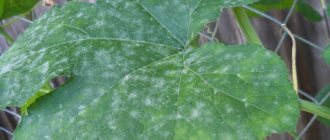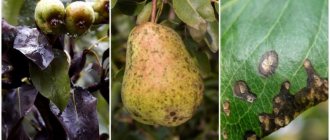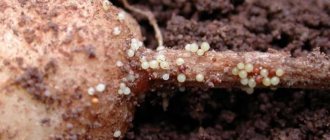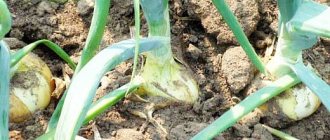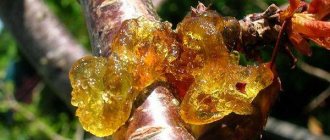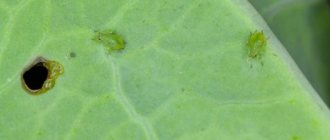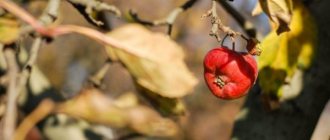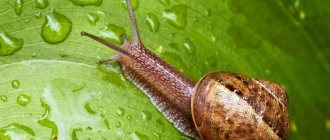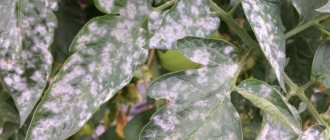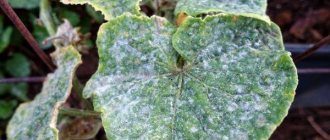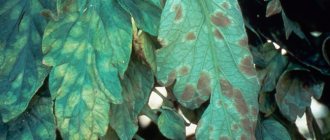Spider mites are dangerous harmful insects from the arachnid family with an average length of 1 mm.
In suitable environmental conditions, it develops quickly and produces up to 5 generations per year, feeds on plant sap, which is why trees very soon lose some of their leaves and lag behind in development.
Infection of an apple tree by these phytophages can lead to loss of yield, decreased plant immunity and its susceptibility to bacterial, fungal, infectious and viral diseases.
It is necessary to carry out preventive measures and visual diagnostics of trees; you cannot hesitate when a spider mite is detected; you must immediately begin the fight against it. In advanced cases, mass reproduction of spider mites can cause the death of apple trees .
Pest varieties
There are many types of this pest and we will give a description of the most common of them, and also show what a spider mite looks like on an apple tree : photos are given below.
Red fruit mite
Polyphagous, up to 0.4 mm long, so they can only be identified with a magnifying glass. The body of the tick is oval-shaped, reddish in color. Externally, red fruit mite infestation looks like light yellow spots along the veins on the leaves , which then darken and die.
Red fruit mite.
Brown fruit mite
Adult insects are up to 0.6 mm long, the body is flat, brown in color. They suck out the juice from both the buds and the leaves, which is why they acquire a reddish or dirty gray tint, dry out and fall off . Mite larvae molt, leaving silvery marks from their skins on the bark in the moulting areas.
Brown fruit mite.
Gall mite
It lives secretly, inside the tissues of leaves and buds, has an even smaller size of up to 0.25 mm, the body is elongated, white, oval, tapering at the back. form on the surfaces of the leaves - spherical swellings of yellow or dark brown color . Due to damage by gall mites, the leaves turn black, dry out and die.
Gall mite and leaf damaged by it.
Kidney mite
The most dangerous mite that destroys young shoots. A diseased bud cannot grow and either does not sprout or produces diseased ones. The main sign of damage by these insects is large deformed buds .
Kidney mite.
Schlechtendahl tick
A less common pest of apple trees. It is 0.2 mm long and yellow-brown in color. The females of this tick species are very fertile and can lay up to 2 million eggs in their lifetime. Due to the active feeding of insects, photosynthesis processes stop and leaves fall off .
Schlechtendahl tick
Prevention
The appearance of spider mites often results in loss of harvest, reduced immunity of trees before the winter season, damage to garden crops by bacterial, viral and fungal infections, and sometimes leads to the death of the plant.
Many residents of the private sector and summer residents try to plant a small garden near their house in order to always have fresh fruits and berries. Favorite trunks that take root in almost any climate without problems are plums, cherries, apples and pears. Sometimes it happens that you cannot wait for the result of your labors due to an invasion of pests; spider mites on apple trees and other fruit trees are especially annoying.
Spider mites on an apple tree: control measures
Methods for controlling any insect pests can be divided into several main groups:
- Chemical method;
- Biological method;
- Agrotechnical method;
- Folk remedies.
Each of them is quite extensive and requires detailed consideration.
Chemical method
This method involves the use of special chemicals, insecticides (from the Latin insectum - insect, caedo - I kill). A group of insecticides aimed at killing ticks is called acaricides (from the Latin acari - tick, caedo - kill).
There are about 50 types of insecticidal and acaricidal preparations of chemical composition, and only 15 active ingredients in different concentrations, on the basis of which they are made.
Manufacturers use various formulations, the main ones of which are:
- Emulsion concentrate;
- Suspension concentrate;
- Water solution;
- Water soluble powder.
Typically, insecticides are applied by spraying or dusting diseased plants.
The drug must be prepared in strict accordance with the instructions, isolating children and pets. Failure to comply with safety precautions can lead to poisoning.
ATTENTION! The chemical method of insect control has a number of disadvantages - environmental pollution, residual amounts of pesticides in products, but if you do not exceed the recommended consumption rates and the number of treatments per season, this will not happen.
Insecticides
The most popular insectoacaricides for controlling mites and other insects on apple trees:
- Fufanon;
- Bi-58 New;
- Karate-Zeon;
- Fitoverm;
- Karbofos.
These drugs have stood the test of time and proven their effectiveness.
In addition to spider mites, the drugs on this list reduce the number of scale insects, false scale insects, leaf rollers, codling moths, flower beetles, and weevils. By treating with such insecticides, you prevent the development of a whole complex of pests.
IMPORTANT! Insecticide treatment should be carried out in dry, calm weather to avoid chemical drift!
A favorite drug of many farmers and gardeners, Fufanon CE is a broad-spectrum chemical insectoacaricide. It contains the chemical compound malathion. Its action is more pronounced and faster.
The pests stop feeding within 2 hours after treatment, and die within a day , but the waiting period before harvesting is 26 days, this is the price for the absolute chemical nature of the drug. During the season, following the instructions, you need to carry out no more than two sprayings.
The pesticide acts on both adult insects and larvae.
Analogues of Fufanon are the drugs Karbafos, Kemifos, Novakation , the difference is only in the amount of the active substance, the highest content in the drugs Fufanon and Karbofos (570 g/l).
Acaricides
Specific acaricides are designed to reduce the number of ticks exclusively . Such drugs have only a contact-intestinal effect (they affect by direct contact with insects), so it is necessary to treat the surface of the trees as thoroughly as possible .
Most often, acaricides are produced in the following formulations:
- Emulsion concentrate;
- Suspension concentrate;
- Wettable powder.
The following acaricidal preparations against mites are available on the plant protection market :
- Sunmite SP;
- Omite SP;
- Mauritius VE;
- Demitan SK;
- Zolon CE;
- Dursban CE and its analogues;
- Tzipi Plus CE;
- Apollo KS.
The determining factor in the effectiveness of an acaricide is the duration of its protective effect. The most pronounced effect is provided by preparations based on propargite (Omite SP), providing up to 15-20 days of protection against ticks.
One of the least toxic drugs for warm-blooded animals and humans is Apollo , and Omite is the most harmful.
The main advantage of specific acaricides is their relative safety for natural entomophages . Unlike broad-spectrum insecticides, they do not kill beneficial insects , which can naturally limit pest numbers.
Biological method
The drug Fitoverm CE has a controversial classification. It is based on toxic waste from the fungi Streptomyces avermitilis, so it cannot be confidently classified as either a chemical or biological method of protection. However, most often it is defined as a biological product.
The advantage of this drug lies in the conditions of its effective operation. Most chemical compounds are unable to destroy the pest at low temperatures in early spring. Fitoverm, EC begins to act already at 18 °C, and at 25 °C it doubles its strength . Fitoverm has a short waiting period of 2 days, after which you can begin harvesting. The recommended frequency of treatments per season is 2-3 times.
The disadvantage of Fitoverm is that, unlike some chemical hormonal acaricides (Apollo), it acts only on adult individuals and does not destroy eggs and larvae.
Aversectin C, which is part of Fitoverm, has a pronounced toxic effect on fish and other aquatic organisms; it should be used with extreme caution near water bodies . Children should not be allowed into the treatment area , since the harm caused to the human body depends on age; it is more dangerous for people under 21 years of age.
ADVICE! To avoid the development of resistance (resistance) in ticks, do not treat with the same drug several times in a row. This provokes the development of defense mechanisms in the insect population. Alternate insecticides from different chemical groups.
Agrotechnical method
This method refers to prophylactic and preventive . To reduce the number of overwintered mites, it is necessary to carry out autumn plowing, destroy weeds, get rid of fallen leaves and remove damaged branches. By burning plant debris, you can destroy the eggs laid by the female mite.
Ticks can also overwinter in cracks in the bark, so you can carefully clean the skeletal branches of fruit trees from loose bark in the autumn-winter period.
To increase the immunity of plants after flowering, foliar fertilizing with complex fertilizers can be carried out.
A radical way to combat spider mites is to trim the affected shoots of the apple tree and then burn them. It is worth resorting to if the spider mite is about to destroy the tree, and treating the affected areas does not give the desired effect.
Folk remedies
An opponent of “chemistry” may also discover that he has a mite on his apple tree: how to treat it in this case? Widespread and favorite among gardeners are folk remedies for fighting spider mites , the recipe for which passes from mouth to mouth:
- Spraying with garlic solution . Peeled heads of garlic (50g) are poured into 10 liters of water, liquid laundry soap is added and the plant is sprayed from top to bottom along the leaves;
- A solution of sulfur-tar soap . 100 g of crushed tar soap is diluted into a bucket of water. Spraying is carried out every week;
- Onion infusion . 200g of fresh onion peels are poured into a bucket of water and left for 1 hour. The infusion is filtered and sprayed on the affected trees;
- Horseradish infusion . Chopped horseradish (400 g) is poured with a bucket of water and left for 2-3 hours;
- A decoction of poisonous black henbane . Use with caution. Pour 2 kg of fresh henbane with water and cook for several hours. Pour the resulting broth into 10 liters of water.
IMPORTANT! These recipes may well bring positive results, but you need to remember that if the number of ticks is high, they will be ineffective and it is necessary to carry out chemical treatment or pruning of trees.
Watch the video on how to treat apple trees against ticks:
Effective ways to fight
The fight against spider mites on apple trees must be carried out comprehensively, using completely different means at the same time.
Chemicals
If a pest appears en masse, you can destroy the pest using special preparations:
They contain malathion, which has a rapid destructive effect on the pest, and have a complex effect, simultaneously destroying other pests - scale insects, leaf rollers, moths and others.
Apply by spraying or dusting in dry weather without wind. Use 30 days before the planned harvest.
The detrimental effect occurs on the second or third day after treatment. The permissible number of treatments per season is no more than 2.
It is recommended to alternate treatment drugs
Targeted chemicals:
They have an extended period of protection against tick-borne parasites, up to 20 days. Many of them include Propargite as an active ingredient. The advantage of their use is that they select the effect only on the pest, without having a toxic effect on other insects.
It is recommended to alternate drugs to avoid resistance.
Biological methods
Biological control methods make it possible to destroy the mite without causing toxic harm to the apple tree and its fruits.
However, they are less effective and are unable to fight at low ambient temperatures, starting to work when the air warms up to 18 ° C and above.
Such drugs include Fitoverm and Apollo; they contain waste products of fungal microorganisms that are toxic to ticks.
The advantage is the possibility of using them before harvesting (2 days before) and increasing the frequency of treatments during the season. They are also capable of having a detrimental effect only on the imago, without destroying the tick larvae.
Traditional methods
Folk remedies help get rid of tick attacks without causing toxic damage to apple trees:
- garlic - 50 g, pour 10 liters of water, add up to 40 grams of laundry soap and spray the trees from top to bottom;
- tar soap - 100 g per 10 liters of water, sprayed weekly;
- onions - infusion of 200 g of onion peel and 10 liters of water, kept for 1 hour, spray the garden crop in the affected areas;
- horseradish - chopped vegetable (400 g) is infused in 10 liters of water for 2-3 hours and sprayed on apple trees;
- black henbane - poisonous berry (2 kg) is boiled in 10 liters of water, increase the volume of liquid to 10 liters and spray the plantings;
- apple cider vinegar (1 tbsp per 1 liter of water) also helps fight against aphids and fungus.
Processing times
To protect the apple tree from spider mites and other pests, there is an established order in which spraying should be carried out during the growing season.
Before the buds open
The first spring treatment is carried out to destroy ticks and other insects that have overwintered on the apple tree.
Before the buds open in March, at temperatures not lower than 5 ºC, you can spray the trees with a solution of copper or iron sulfate . Also treat the soil around the apple tree with this solution, because many pests also overwinter in it.
After bud break
The next spraying should be carried out after the buds open and before flowering begins (in May). Treatment can be carried out with any of the insecticides or acaricides mentioned above.
During flowering
Spraying during flowering is undesirable . Chemical exposure during this period can negatively affect the harvest and cause the death of bees and other beneficial insects.
Spraying should be carried out only as a last resort, if you were unable to treat the trees against mites before flowering, and their numbers pose a threat to the apple tree.
During fruiting
The next treatment should be carried out at the beginning of fruit growth (June). The same insecticides should not be used several times in a row.
ATTENTION! You cannot spray apple trees while the fruits are ripening; the last treatment with chemicals should be carried out on average a month before harvest!
Damaged fruits and branches are removed and burned.
Final processing
The last treatment is carried out after harvest and before the leaves fall with insecticides, copper sulfate or urea to kill mites that have remained over the winter.
Consequences of spider mite infestation of apple trees
Ask and receive useful advice from professional gardeners and experienced summer residents.>>
The difficulty of controlling the pest is that at the early stage of damage to apple trees, this insect is practically undetectable. It reproduces incredibly quickly. A week after laying the eggs, a full-fledged insect is already formed, ready to continue its genus.
Reasons for the appearance and reproduction of spider mites
Spider mites actively move in search of food. They enter the room:
- through open windows and doors;
- with clothes;
- with bouquets of flowers or potted plants, both purchased and brought into the house after being outside in the summer;
- when transplanted into soil contaminated with pest eggs.
Insects are carried into the garden by the wind from neighboring areas or when planting infected seedlings and seedlings. At an air temperature of 25–30°C, the larva grows into an adult in 8 days. At moderate temperatures this lasts a month.
In hot climates, insects breed all year round. In our latitudes, outdoor pests go into hibernation for the winter and therefore look for shelter in the fall. They hide in plant debris and fallen leaves, in the top layer of soil, and in greenhouse structures. This does not apply to indoor pests. There is no respite for them here and they are dangerous to plants all year round.
Spider mite infestations pose additional threats to plants. Perhaps the appearance and spread of gray rot and various viruses. Yield losses can be up to 70%
